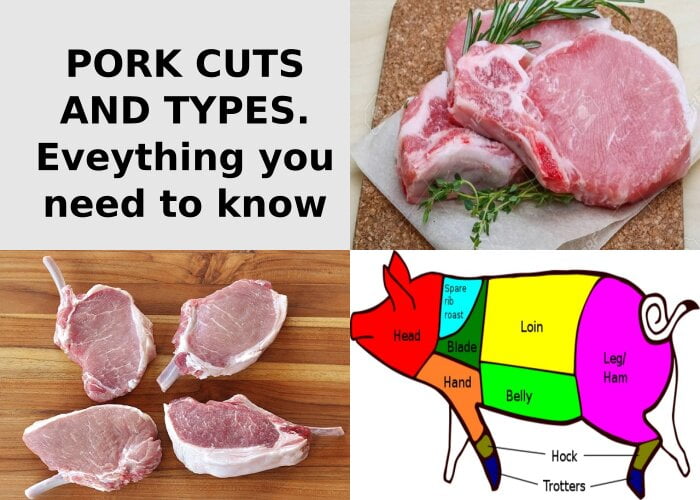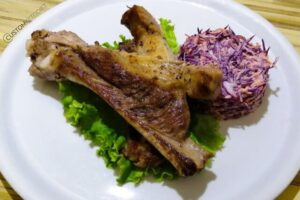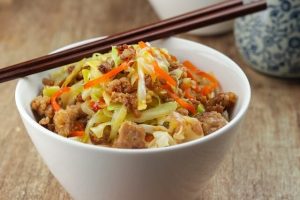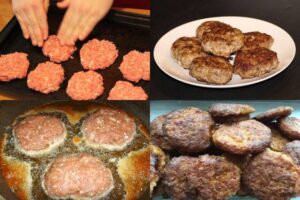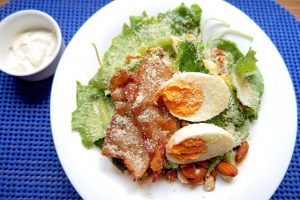Pork is a popular protein that is used in many recipes all over the world.
From familiar cuts like pork chops and bacon to more exotic cuts like spare ribs and pig feet, this versatile meat can be enjoyed cooked many different ways.
In this guide, you’ll learn about the cuts of pork, their best cooking methods, and how long each cut should be cooked for optimal flavour.
What ss pork? A comprehensive guide
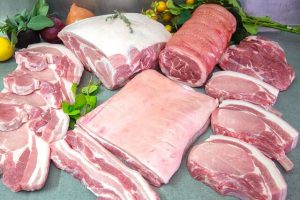 Pork is a type of red meat that comes from animals such as swine, pigs, and boars.
Pork is a type of red meat that comes from animals such as swine, pigs, and boars.
Pork is the culinary name for the meat of the domestic pig.
It is eaten both freshly cooked and preserved.
Curing extends the shelf life of the pork products.
Ham, smoked pork, gammon, bacon and sausage are examples of preserved pork.
Pork is one of the most popular meats in the Western world.
It is also very popular in East and Southeast Asia including Mainland Southeast Asia, Philippines, Singapore, East Timor, and Malaysia.
This meat is highly prized in Asian cuisines, especially in China, for its fat content and texture.
Some religions and cultures prohibit pork consumption, notably Islam and Judaism.
Types of Pork
There are many different types of pork – from cured meat products like bacon to delicious roasts.
Each type of pork has a different flavor and texture, as well as an array of uses.
Common types of pork include shoulder, loin, ribs, ham, bacon, sausage, and ground pork.
Each one can be cooked in a variety of ways depending on the desired flavour or texture.
Choosing the Best Cooking Method for Your Dish
Different cuts of pork will require different cooking methods to achieve the best results.
For instance;
- Chops and roasts are usually cooked like steaks or roasts- grilled, seared, roasted or braised.
- Ground pork is often used in soups, stews and stir-fries.
- Ribs can be cooked low and slow on the grill or in the oven, boiled to make your own stock, or smoked for a signature backyard barbecue flavour.
Knowing which cut you have and what the ideal cooking method is will help you create a delicious meal that’s sure to impress even the pickiest eaters!
The Nutritional Value of Pork
Pork is an excellent source of high-quality protein, B vitamins, minerals and polyunsaturated fatty acids.
It contains essential amino acids your body needs to build and maintain muscle mass, including leucine which helps with muscle strength and recovery.
Pork also provides a good source of important minerals such as phosphorus, iron, zinc, selenium and magnesium.
Identifying Different Cuts of Pork
When you shop for pork, it’s important to understand the different types and cuts of pork.
Knowing which cut of pork is best suited for your specific cooking method will ensure that you get delicious, juicy results every time.
The most common cuts are chops (bone-in or boneless), loin roasts, ground pork, and ribs.
Each cut has its own shape, texture, flavour profile and cooking time.
Pork cuts of meat
Head
 Head meat, also known as pork head or pigs head, is a cut of meat from the head of a pig.
Head meat, also known as pork head or pigs head, is a cut of meat from the head of a pig.
Pigs head are prized in many culinary cultures for their succulent, rich flavor, as well as for their high nutritional value.
The meat is also full of important vitamins and minerals, making it a nutritious option for those looking to add variety to their diet.
The head of the pig can be used to make brawn, stocks, and soups.
Best cooking methods for pig head
- Head cheese, or brawn, is the best way to cook a pig’s head.
This dish involves simmering the whole head in a flavourful broth of herbs and spices before turning it into a savoury jelly and slicing it. - Boiling a pork head can bring out the flavours of the meat and lends itself to many traditional dishes.
Boiling pork requires you to simmer the meat gently in liquid for a few hours until it is fork-tender, allowing it to fully absorb any spices and herbs you add to the pot.
- After boiling, the ears can be fried or baked and eaten separately.
- The cheeks can be cured and smoked to make jowls.
- The lower parts of the head as in the neck, is perfect slow cooked and pulled.
Shoulder/Forequarter Roast
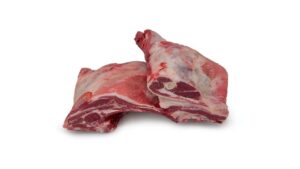 Forequarter roast is taken from the pork shoulder, which is the top portion of the front leg of the hog.
Forequarter roast is taken from the pork shoulder, which is the top portion of the front leg of the hog.
The upper part of the shoulder, often called the blade pork roast, comes from the area near the loin and contains the shoulder blade bone.
This is a well-marbled cut and is versatile enough to be pot-roasted whole, cut up for stews or cooked over moist smoke in a smoker to transform it into classic pulled pork barbecue.
The forequarter roast is available bone-in or boneless.
Best cooking methods for forequarter roast;
- Roasted
- Braised
- Barbecue smoked
Whether it is roasted, braised or barbecued, blade roast becomes meltingly tender and deliciously flavourful.
Blade shoulder
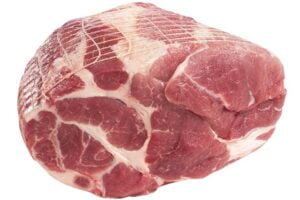 is an American cut. It comes from above the front limbs and behind the head is the shoulder blade.
is an American cut. It comes from above the front limbs and behind the head is the shoulder blade.
Also known as spare rib roast and joint, it is not to be confused with the rack of spare ribs from the front belly.
Pork butt, despite its name, is from the upper part of the shoulder.
The Boston butt, or Boston-style shoulder cut, comes from this area and may contain the shoulder blade.
It can be boned out and rolled up as a roasting joint, or cured as bacon.
Best cooking methods for Blade shoulder;
- Oven roasted
- Braised
- Barbecue smoked
Pork Shoulder Chops
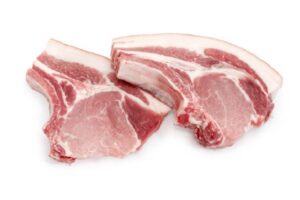 Shoulder chops are from the blade roast includes a bit of the shoulder blade and are fattier and a bit tougher than other “chops.”
Shoulder chops are from the blade roast includes a bit of the shoulder blade and are fattier and a bit tougher than other “chops.”
They are also known as blade chops.
For best results, I suggest marinating or tenderising before cooking.
Best cooking methods for pork shoulder chops;
- Barbecue grilled
- Braised
- Grilled/broiled
- Pan-fried
Pork Collar Butt/Neck
 The collar butt (or neck), produces delicious meat, which should be slow cooked wherever possible to allow intramuscular fat to melt, keeping the meat moist and tender.
The collar butt (or neck), produces delicious meat, which should be slow cooked wherever possible to allow intramuscular fat to melt, keeping the meat moist and tender.
Pork shoulder cuts are diverse and can be roasted, used for steaks, diced or minced.
Best cooking methods for pork neck;
- Oven roasted (iow and slow)
- Barbecue smoker.
- Braising.
- Long, slow cooking methods will yield tender results.
Pork Loin Roast
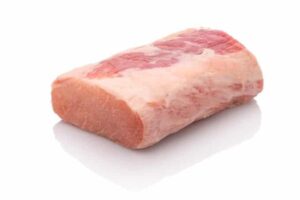 Pork loin roast is an extremely versatile and delicious cut of pork taken from the area between the shoulder and the leg.
Pork loin roast is an extremely versatile and delicious cut of pork taken from the area between the shoulder and the leg.
Though it can be bought either bone-in or deboned, leaving the bone in will give an extra layer of flavour to the dish.
Pork loin roasts should not be cooked using moist heat, such as braising or stewing, since they will lose their tenderness and fall apart easily.
Instead, marinating, brining or seasoning with a spice blend before cooking over indirect heat is probably the best way of cooking this popular cut.
Best cooking methods for pork loin roast;
- Oven roasted
- Barbecue smoked
Pork Loin Chops
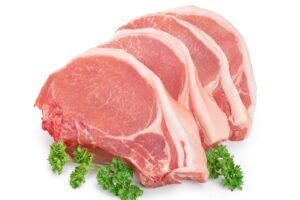 Loin chops have a T-bone shape. One side of the bone has loin meat and the other side has tenderloin.
Loin chops have a T-bone shape. One side of the bone has loin meat and the other side has tenderloin.
(a.k.a. pork strip chops) are sometimes sold boneless and called pork loin fillets
Best cooking methods for pork shoulder chops;
- Barbecue grilled
- Braised
- Grilled/broiled
- Pan-fried
Pork Leg Roast
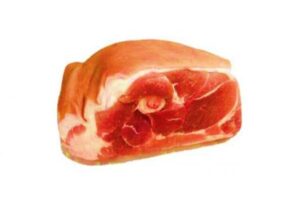 A traditional bone-in roast, this cut is usually covered in a thick layer of fat and skin, which should be scored before roasting.
A traditional bone-in roast, this cut is usually covered in a thick layer of fat and skin, which should be scored before roasting.
This cut is not as fatty as you might think and benefits from brining.
Available with the bone in or out, this is the most common roasting cut that is characterised by its tender meat and layer of skin and fat that turns
into delicious crackling when cooked.
Best cooking methods for pork leg roast;
- Oven roasted
- Barbecue smoked
Pork Leg Steak
 Pork steaks from the hind quarter rump or upper leg.
Pork steaks from the hind quarter rump or upper leg.
These steaks have a lot of beautiful fat marbling, which means they are juicy, tender and have a lot of great flavour.
These lean steaks can be left whole, or can be diced for a casserole, they are also ideal when flattened and crumbed or breaded for schnitzels.
Best cooking methods for pork leg steak;
- Pan Fried
- Barbecue hotplate or grill.
Pork Hock Shank
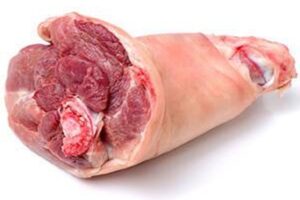 Hock and shank are flavourful, inexpensive cuts that originate in the front leg of the hog, known as the arm picnic shoulder.
Hock and shank are flavourful, inexpensive cuts that originate in the front leg of the hog, known as the arm picnic shoulder.
The hock is the lower, meaty portion of the front leg.
Hock contains two round shank bones that are exposed on both ends and is often sold with the skin still attached.
Thanks to its abundance of connective tissue, hock and shank provide a rich, smoky flavour that is ideal for enhancing soups, stews and rustic vegetables.
Hocks are best enjoyed when the meat becomes so tender that it nearly falls away from the bone.
Add a hock to hearty winter soups, especially those containing grains and pulses, to add depth and flavour.
Simply chop the cooked meat and add to the dish near the end of cooking time to enhance taste.
Best cooking methods for pork hock shank;
- Long, slow cooking methods will yield tender results.
Pork Belly
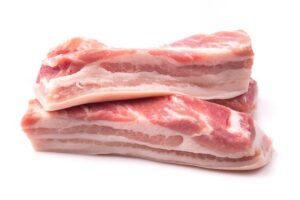 Pork belly is a traditional favorite and then some! Cut from the underside of the pig, this fatty piece of meat packs more flavour than lean meats do.
Pork belly is a traditional favorite and then some! Cut from the underside of the pig, this fatty piece of meat packs more flavour than lean meats do.
Pork belly comes from a hog’s ‘belly’ or underside after the loin and spareribs have been removed.
This boneless cut may be served fresh, which means it is not cured or smoked.
Fresh belly is succulent and richly flavourful and is often served in small portions.
Pork belly is at its best and is most tender when prepared using a slow cooking method, such as braising.
Best cooking methods for pork belly;
- Oven roasted (iow and slow)
- Barbecue smoker.
- Long, slow cooking methods will yield tender results.
Pork Spare Ribs
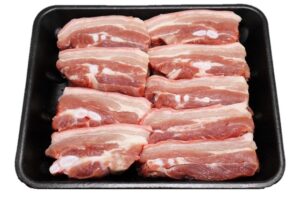 Spare ribs come from the belly of the hog and are known for their delicious, meaty pork flavour.
Spare ribs come from the belly of the hog and are known for their delicious, meaty pork flavour.
These ribs are the least meaty variety of ribs, but full of flavour.
Best cooking methods for spare ribs;
Pork Rib Chops
 Rib chops lie between a pig’s shoulder and the middle of the loin.
Rib chops lie between a pig’s shoulder and the middle of the loin.
They feature a big piece of lean loin meat with some fat on the edges and a rib bone along one side.
Pork rib chops can also be known as pork rib cut chops, rib pork chops and pork chop end cut.
Best cooking methods for pork rib chops;
- Barbecue grilled
- Braised
- Grilled/broiled
- Pan-fried
Pork Tenderloin/Fillet
 Pork tenderloin also known as pork tender and pork fillet are extremely popular.
Pork tenderloin also known as pork tender and pork fillet are extremely popular.
Pork tenderloin is one of the leanest, most tender cuts of meat on the market, so it can also be a little expensive
They are lean, tender, and boneless. They are also easy to cook.
Best cooking methods for pork tenderloin;
The key word here is quick.
- Quick roasting.
- Quick grilling/broiling.
- Quick barbecue grilling.
- Quick sautéing.
- Quick braising.
Knowing How Long to Cook Different Cuts Of Pork
Knowing how long to cook different cuts of pork will allow you to ensure the meat is cooked thoroughly and safely.
Generally, the rule of thumb is to roast or brown chops, steaks, and roasts in an oven preheated to 350°F and cook them until they reach an
internal temperature of 65°C (145°F).
For ground pork, a minimum internal temperature of 74°C (165°F) should be reached with a food thermometer.
Finally, ribs can usually be boiled for 30 minutes and then slow-cooked on the grill or in the oven at 110-120°C (225-250°F) over indirect heat for 2-3 hours.
Best Cooking Times For Roast Pork Cuts
For a pork roast, it is best to use a meat thermometer to check the internal temperature of the meat – but this is not essential.
| Pork Cut | Oven temp | Cook time | Internal meat temp |
|---|---|---|---|
| Loin | 160°C (320℉) | 35-45 minutes per 500g of pork. | 71°C (160℉) |
| Whole fillet | 170°C (325℉) | 25-30 minutes per 500g of pork. | 71°C (160℉) |
| Scotch fillet | 170°C (325℉) | 25-30 minutes per 500g of pork. | 71°C (160℉) |
| Shoulder | 160°C (320℉) | 35-40 minutes per 500g of pork. | 71°C (160℉) |
| Leg | 170°C (325℉) | 30-35 minutes per 500g of pork. | 71°C (160℉) |
| Rolled Leg | 170°C (325℉) | 25-35 minutes per 500g of pork. | 71°C (160℉) |
Why You Should Use a ChefsTemp Thermometer When Cooking
A ChefsTemp thermometer is an essential tool for any cook or baker.
It allows you to monitor the internal temperature of your food more accurately, which helps you achieve consistent results and perfect textures.
Additionally, it can be used to make sure that food has reached safe temperatures, ensuring that it's safe to eat.
Unlike other thermometers, the ChefsTemp reads quickly and accurately in both Celsius and Fahrenheit.
- ChefsTemp Pocket Pro
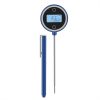
- Description:Professional thermocouple probe sensor with 1 second reading time, this pocket size kitchen gadget is suitable for both professional chefs and home cooks. Pocket Pro is another amazing innovation from ChefsTemp. It is a 4-way rotating display thermometer,
- Price: $34.99
- ChefsTemp Finaltouch X10
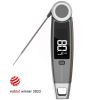
- Description:Finaltouch X10 is the Winner of Red Dot Product Design in 2022. The Red Dot Design Award is one of the three most prestigious professional design competitions in the world. Winning the award proves its the Leader in Design and Technology. Chefs around the
- Price: $69.99
- ChefsTemp Quad Xpro
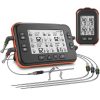
- Description:Quad XPro is designed to track temperatures over an extended period of time with moderate-heat cooking methods, such as smoking, oven-roasting, deep-frying, home brewing, and Sous Vide and to be used while grilling.
- Price: $109.99
12 Essential Cooking Tips For Perfectly Cooked Pork
Cooking pork can be a challenge – but not with our 12 top tips!
Nail the perfect texture and flavour of each delicious pork dish with these cooking guidelines.
- Do not overcook pork or it will become dry and tough.
Pork doesn’t need to be overcooked to be safe. In fact, pork can be eaten with a hint of pink in the middle (with the exception of mince and sausages).
The threat of trichinosis is eliminated when the pork is heated to 71°C (160℉) to be safe. - Like all meat, pork continues to cook after removal from heat.
For best results, let your dish rest uncovered for 1-2 minutes in a warm environment prior to serving (except for sausages and mince). - When frying or sautéing, do not place a cover over the pan. This will lock in moisture and cause the meat to braise or steam.
- Lightly coat pork with vegetable oil to keep it from drying out during cooking.
- Before roasting pork, sear all sides to create a flavoruful crusty surface on the meat.
- Do not overcrowd pork cuts when cooking. Leaving space between them will allow them to brown and cook more evenly.
- If using a marinade for basting, set some aside before placing raw pork in it to marinate.
Never reuse marinade that the meat was marinated in. - Poach uncooked pork sausages for a few minutes before frying, broiling or grilling.
Sausage casings should not be pierced before poaching.
Piercing will cause the juices to be released and sausages will become dry. - Do not partially cook pork and then store in refrigerator to use later.
It must be cooked until done.
It can be partially cooked or browned using one method, such as microwaving or searing, and then immediately cooked until done using a different method, such as roasting, frying, grilling or broiling. - Always cut meat across the grain to keep tender.
- Avoid frequent prodding of the meat while cooking.
- For best results, meat should be brought to room temperature prior to cooking.
Answering the Top 6 FAQs About Pork
Get your facts straight about pork with these helpful FAQs that answers questions in an easy-to-understand format.
What Pork To Use For Pulled Pork?
For a classic pulled pork, a pork shoulder is the favourite.
You might also see it referred to as a Boston Butt or pork butt.
Collar butt or neck is another winning option.
Because of the fat and marbling, both these cuts will provide the moistest pullable result for your pulled pork.
What Is Marbling In Pork?
Marbling is the mottled pattern of fat within a cut of meat. Marbling adds flavor and retains juice to cooked roast pork, making it juicy and flavourful.
The more marbling present, the more tender and flavourful the roast pork when slow cooked.
Is It Safe To Eat Rare Pork?
Although some people are comfortable eating pork that is slightly pink in the middle, it’s not safe to eat pork that is raw or undercooked.
Undercooked pork can harbor parasites and other bacteria, leading to serious illnesses.
Therefore, for safety reasons, it’s best to cook all types of pork to an internal temperature of 63°C (145°F).
What Pork To Use For Sweet And Sour Pork?
For sweet and sour pork, the meat should always be lean, such as shoulder or loin pork.
These cuts of the animal are the most tender and absorb flavours best, making them perfect for this dish.
which Pork Is Best For Roasting?
Roast pork is a classic dish popular all around the world.
The most popular cuts for roasting are the pork leg and loin joints, which have lean meat and crackling that makes them especially tasty.
For those who like something richer, then shoulder joints and pork belly roast should work perfectly.
These cuts have more fat content that melts while cooking, resulting in juicy, tender meat.
Which Pork Roast Is The Most Tender?
For a truly tender pork roast, opt for loin roasts, which come from the back of the pig.
The tenderloin and center-cut rib roasts are even more tender than other cuts of pork, but they tend to be much smaller in size.
Alternatively, look for sirloin roasts, which come from the hip area and can be cut into smaller roasts as well.
Recipes Using Pork
See all our recipes using pork here
